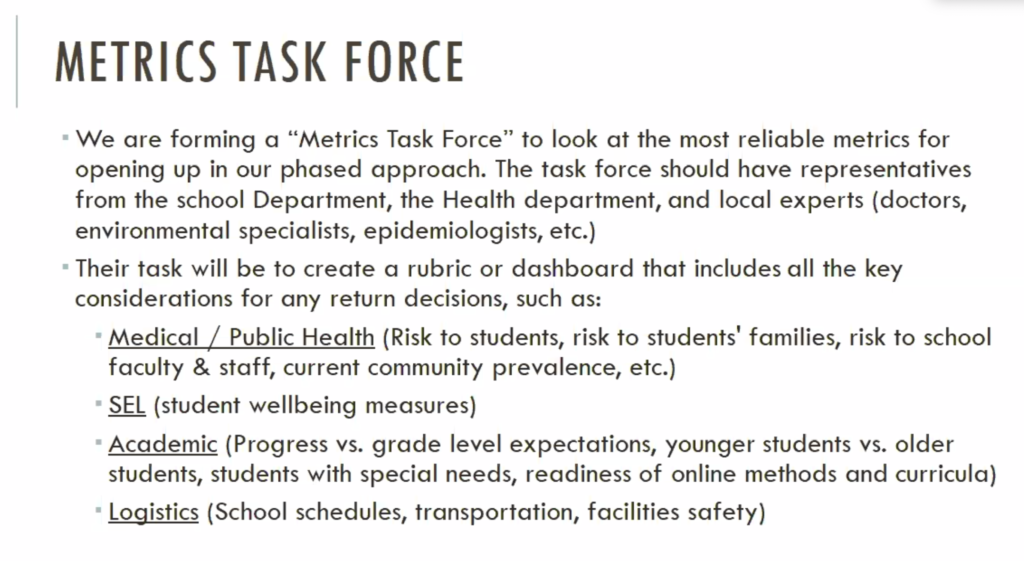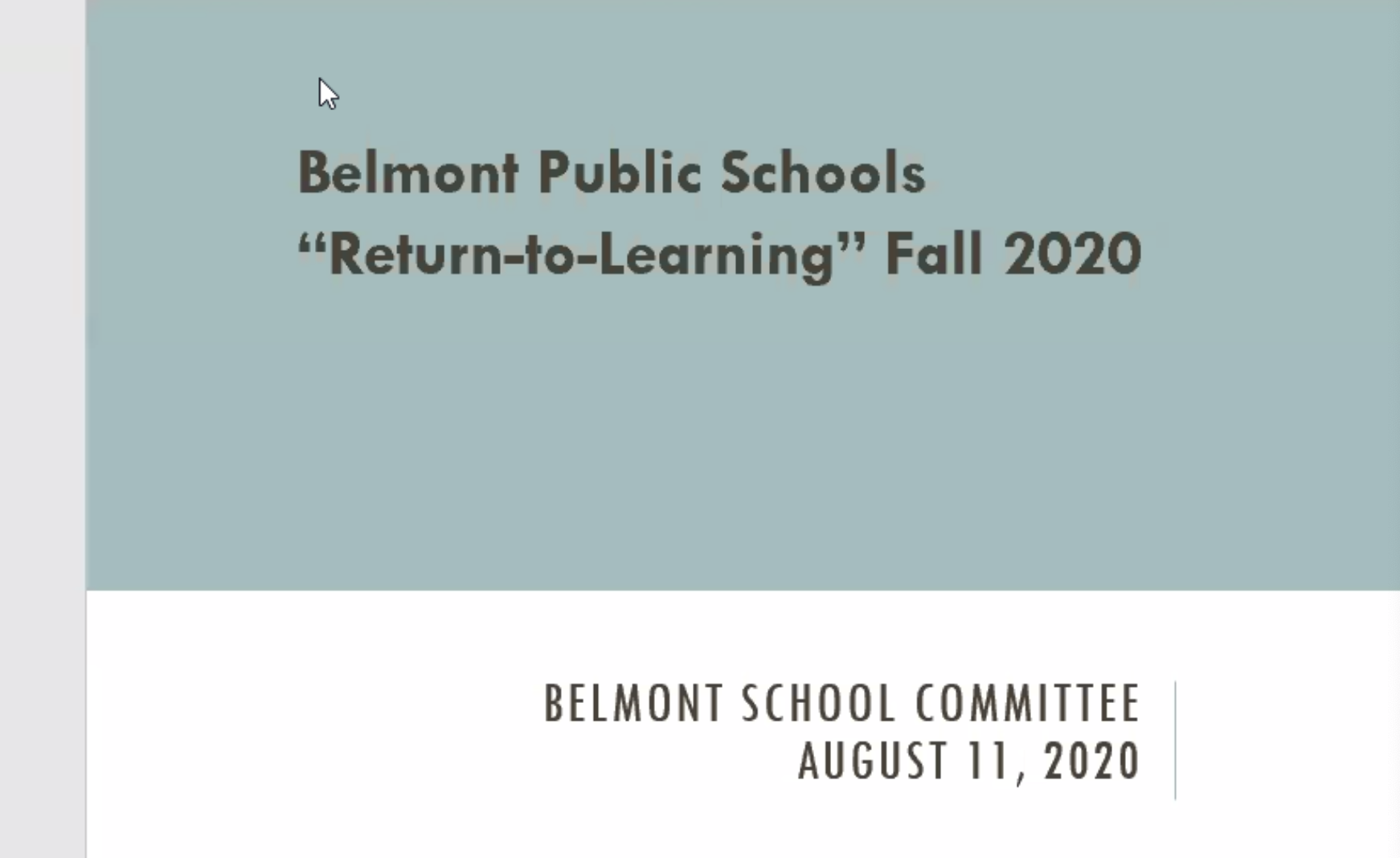Photo:
While many neighboring communities are diving into the 2020-21 school year with at least some in-class instruction, the Belmont School Committee approved unanimously on Tuesday, Aug. 11 one of the most conservative reopening programs proposed in the state, a four-part phased approach that requires Belmont’s 4,800 students to move through a pair of remote learning stages before reaching the hybrid stage.
While acknowledging the best learning is when students are taught in a classroom with a teacher, due to the lack of testing and contract tracing as well as a recent uptick in positive COVID-19 cases in the state, starting classes online for all grades was the safest option said Belmont Superintendent John Phelan to the committee at a community forum held on Thursday, Aug. 6.
“We have to prioritize and put in an order that matched up with the priorities that we set at the beginning [of this process] which are safety, social emotional well being of students and staff. So I feel like the conversation really needs to revolve around safety,” said Phelan.
But at least half of the committee voiced their hesitation making their decision, not so much against the plan but that several important aspects of the plan appeared to them lacking on a myriad of issues such as testing and how moving from one phase to the next will be determined.
“With reluctance because I think we have a lot of work left to do,” said Committee member Mike Crowley, who had suggested delaying a vote until many outstanding issues were answered.
The 170-day school year is scheduled to start on Wednesday, Sept. 16 with students K-12 being taught online with the exception of those with complex and special learning needs.
Belmont joins many of the largest school districts in the country and nearby communities – Somerville, Wayland and Swampscott – who will open via the internet. Other districts such as Arlington, Bedford, Danvers, Plymouth, Shrewsbury, Wellesley and Woburn will start in a hybrid mode.
Based on two recent parents survey results and emails to the media and school committee members, nearly two-thirds of parents prefer some form of hybrid start for school.
The reaction among those who attended the two meetings ranged from enthusiastic support to not being thrilled by the decision.
“Smart move, Belmont! It’s important to think about the health and safety of the students, teachers and community. Not only does this protect Belmont but also the commonwealth of Massachusetts,” said Dianne Cohen DeChellis in a Facebook comment.
“Pure BS,” noted one father – who did not want to give his name as he will likely seek to volunteer for a proposed task force. “[Massachusetts Gov. Charlie] Baker released a map showing Belmont is one of the safest communities when it comes to COVID-19 exposure. It’s depressing.”
Baker stated at a Friday, Aug. 7 press conference the facts, data and science doesn’t support “everybody” reverting to a remote model in reopening schools.
The decision also prompted a petition on change.org calling for Belmont to start the year with the hybrid approach for all students. The petition authored by Christine McLaughlin garnered approximately 500 signatures.
The divergence between the district’s supporters and critics is shadowed by the wide variety of opinions promoting either caution or a green light approach to reopening schools. An interactive map from the New York Times dated Aug. 14 suggests Belmont – “where the rate of new coronavirus cases may be low enough, and testing rates in the state high enough” – can safely open its four elementary school and the Chenery Middle School and allow Belmont High to begin the year in a hybrid option. On the other side, a report by WGBH had a Harvard epidemiologist calling the hybrid model for reopening ‘is “Probably Among The Worst’ Options.”
Tuesday’s vote, which attracted 500 residents viewing the meeting on Zoom, came five days after the Belmont school superintendent surprised the community by recommending starting the new school year remotely, emphasizing the health and safety of pupils and staff.
“We can create a robust and remote environment that can continue learning and moving forward, engage students academically and we can connect with children as best we can,” said Phelan. “But we can’t do that in-person until we know it’s safe.”
The district’s decision – which was originally set to be presented to the school committee at the Aug. 11 meeting – was a jolt to those attending the forum.
“I have to say I’m suffering from whiplash just a little bit,” said a clearly surprised Andrea Prestwich, chair of the school committee, after the announcement. “Just a few weeks ago … we were absolutely certain that we were going to go back into hybrid mode. And now here we are going back from it.”
The district’s recommendation on using a remote plan comes just two days after at a school committee meeting in which it went into details of the hybrid and remote plans, spending a majority of the presentation emphasizing a hybrid option in which students would attend school in-person for two consecutive days and learning the remainder of the time via Google Classroom.
Thursday’s meeting was originally a Q&A with parents and students questioning school officials and committee members on the three education options – remote, hybrid and in person – required of each district by the state’s Department of Elementary and Secondary Education. But Phelan said he gave the recommendation early so parents would have the weekend to review the decision.
In the view of the district, the four part reopening plan creates “a pathway” so that all students “in a very methodical way” towards the “total goal … to have all student back in school. But that strategy can only move forward by securing the safety of the students and staff,” said Phelan.
The district’s recommendation for the school year consists of four phases; two remote, a hybrid and in-school options. [see table below]

Phelan said remote learning in 2020-21 will not resemble the haphazard approach in the final three months of last school year closed due the COVID-19 pandemic. The out-of-class learning in the fall will be a robust real-time “virtual school” with synchronous educator-led learning in which instructors will collect and assess assignments provide feedback and grade assignments including tests and quizzes.
Students will “attends” classes for the entire day based off a synchronized schedule. Assignments will be found on an academic hub with homework expected from each student.
“I believe parents want to know two things; … what’s going to happen in the fall so they can plan and they want to know what each phase will look like so they know what’s going to happen,” said Phelan.
Phelan said the district’s next step is to create detailed remote and hybrid schedules for the School Committee to vote in the next few weeks.
“We know our families want more detail on these models, and we have been planning our models with our educators,” said Phelan in a statement.
During the discussion between committee members at Tuesday’s meeting – public comment was reserved to Thursday’s forum – a major concern for several members would be the mechanism in which the district will move from one phase to the next.
“I know people want that information now and we have some of it, but we don’t have all of it, saying they will have that detail in the next week, maybe two weeks,” said
Phelan said the district will establish a Metric Task Force made up of residents, health experts and educators (see below).

The first issue facing the task force will be determining what data will be used in the rubric and the measurable level or condition that “opens the door” to allow the district to move to between phases.
While still in its genesis – no members have been named – it appears the task force will only have an advisory role to the school committee, making recommendations on which phase the district should be in to the committee which will likely have the final say. Another unknown is how long it will take from when a recommendation is accepted to when it’s implemented.
Another issue is surveillance testing students and staff for the virus which Prestwich has spearheaded. Through her research Prestwich has discovered many districts are looking at daily testing a one percent random sample of students – about 50 students in Belmont – to determine the absolute levels of infection. The cost for six months of testing is $250,000, a price tag Prestwich said “will be money well spent.” She also believed that less accurate but much faster daily tests – approximately 90 percent accurate at $1 per test – could be better for the district’s purposes of identifying and containing any outbreak.
But a source of funding remains a stumbling block as the district faces a $9 million deficit and it’s uncertain additional funds to cover COVID-19 costs from the federal government or the state will arrive.
A major priority for the district is the effectiveness of the movement of air in the ventilation system in each school. New research has found more evidence that COVID-19 can be spread through aerosol transmission rather than through contact with surfaces. Phelan said the district has yet to begin the process of assessing the air handling equipment in the district’s six school buildings which will likely take up to a month to conclude just as classes start.
Committee member Kate Bowen had hoped to review the eight hybrid options to reach a consensus on “what is the right hybrid situation” since having a preferred option would allow families to plan ahead their employment and child care issues.
But Phelan said the question on the community survey was not to select a preference on a specific hybrid plan but to register “how the impact of any hybrid model will have on your family.”
“I will take full criticism for not having full baked hybrid and full baked promote plans, even though we’ve been discussing this internally at great length,” he said. But absent testing and a complete air movement assessment, Phelan said the overriding question is “are we able to enter school to even entertain a hybrid model?”
School Committee member Tara Donner agreed with Phelan. “I think the benefit of moving forward with the face plan today is that we free up our administrators to focus 100 percent on developing these metrics … and I know that [Phelan and assistant superintendent Janice Darius] are committed to having these kinds of meetings, even if we start in a remote plan.”
But, she added, “We should move as fast as we can from phase 1 to phase 2 and I’m fully in support of robustly immediately devoting a lot of resources to developing the metrics that we can use to go forward.”








Leave a Review or Comment